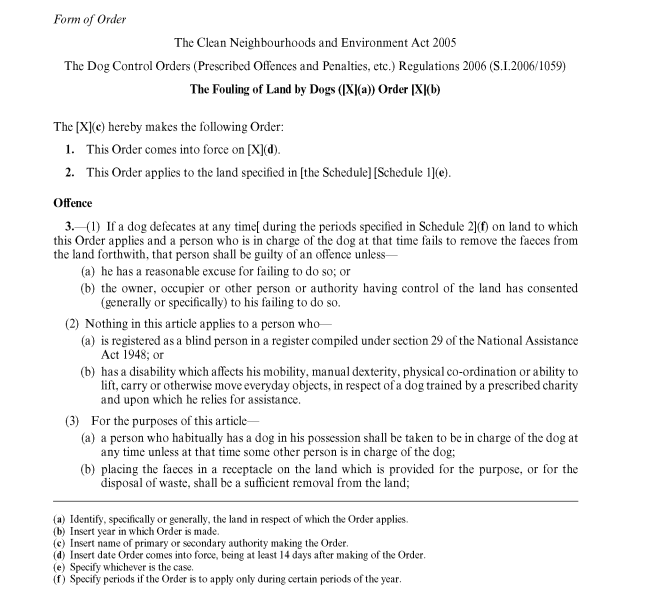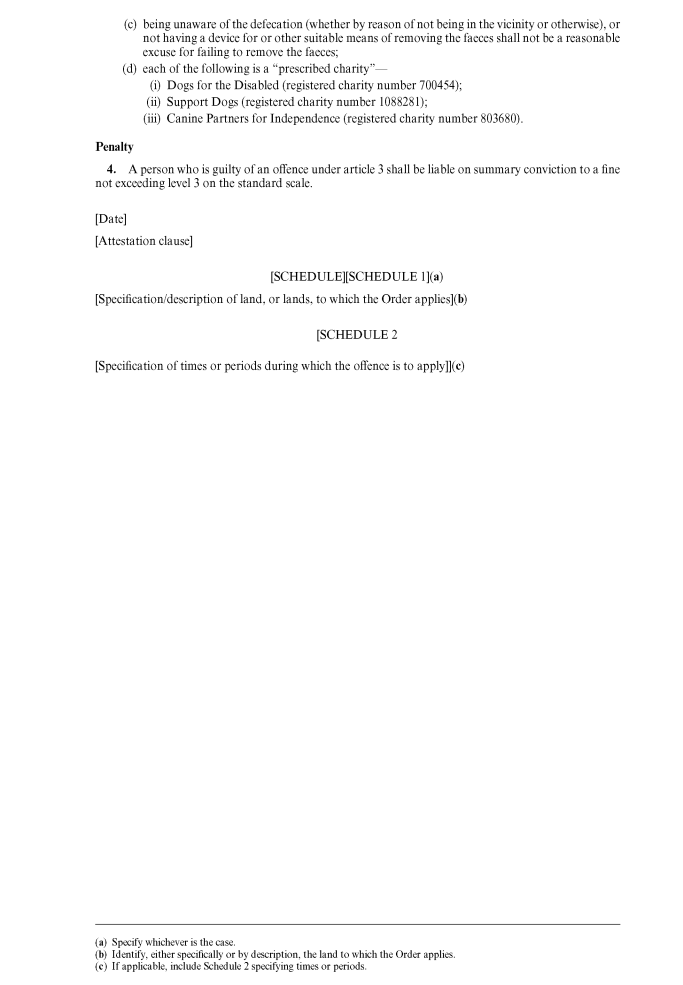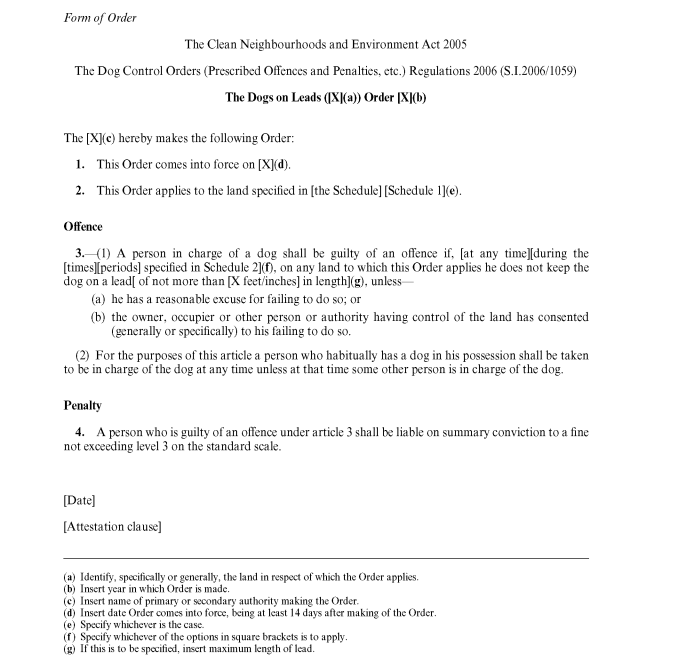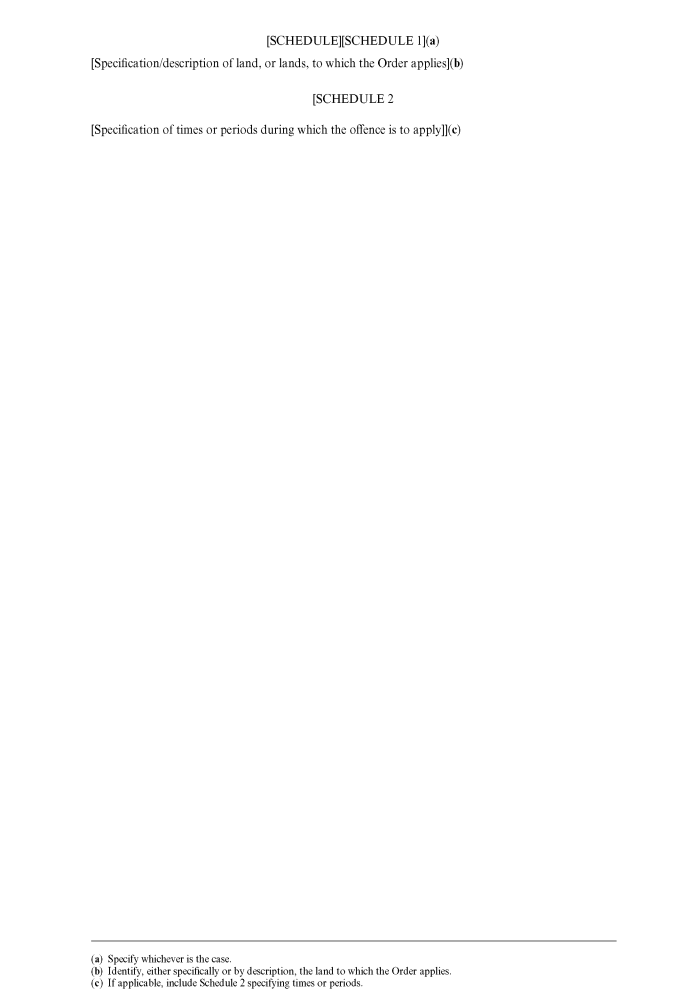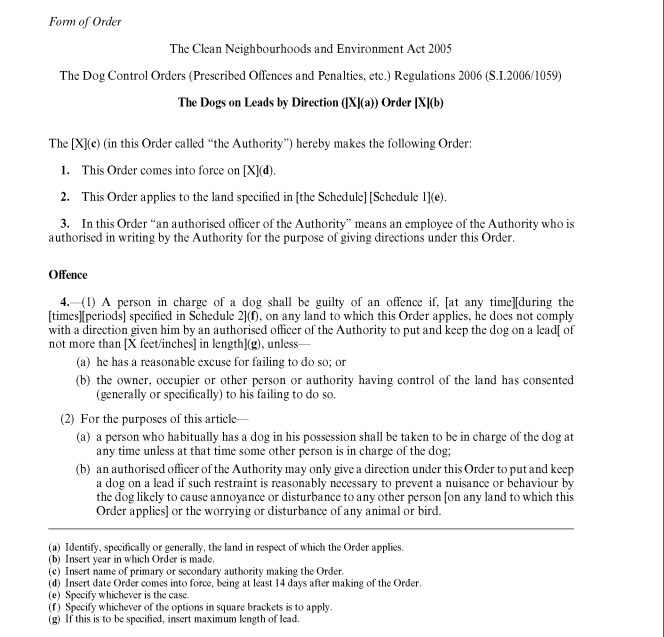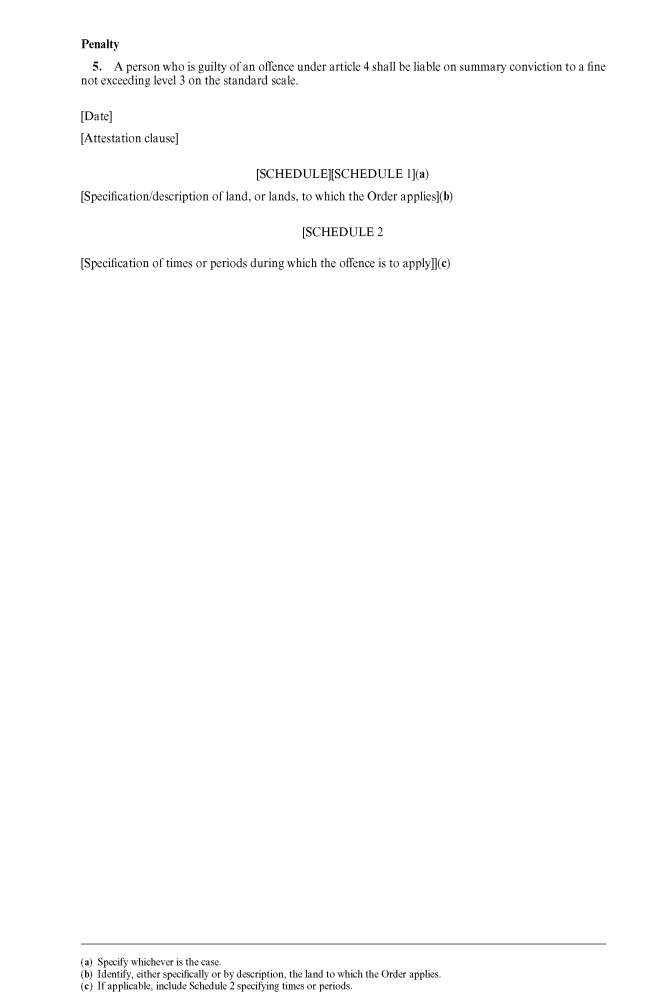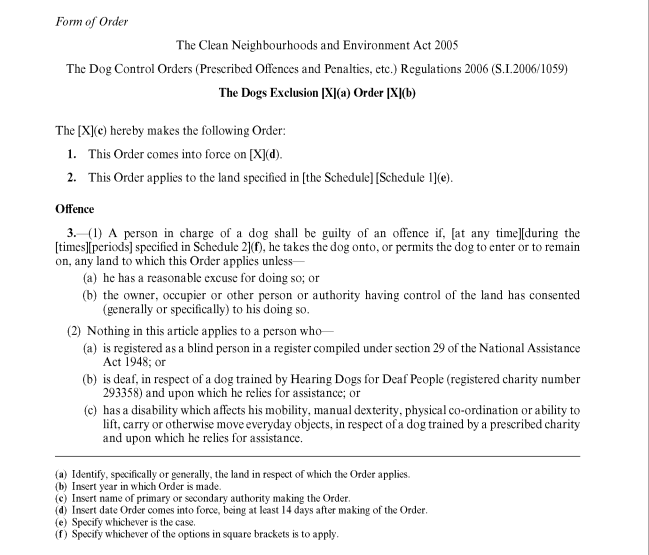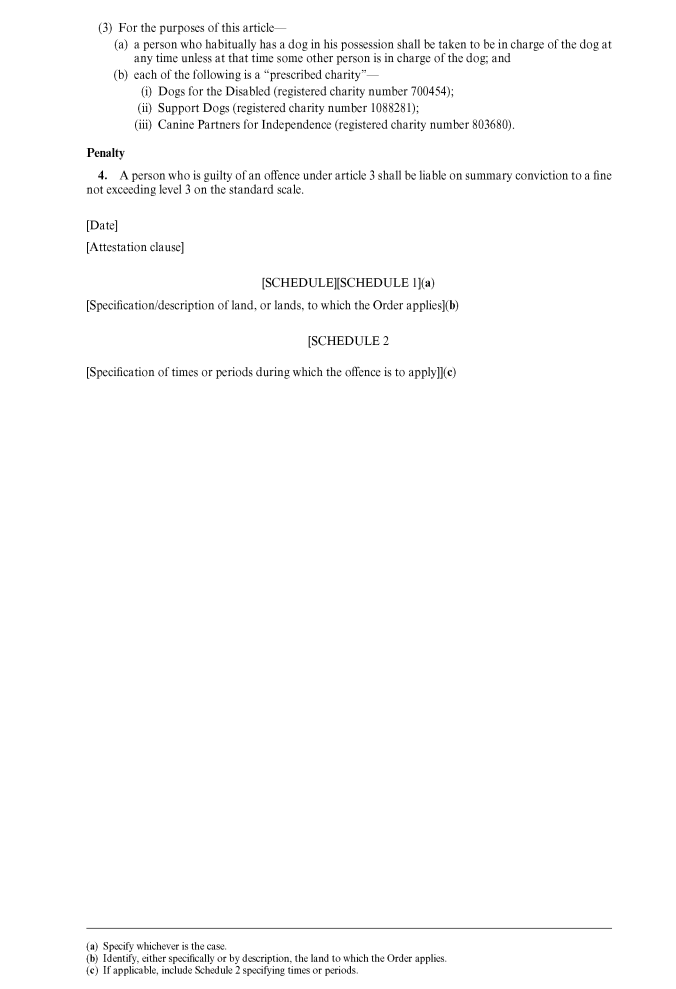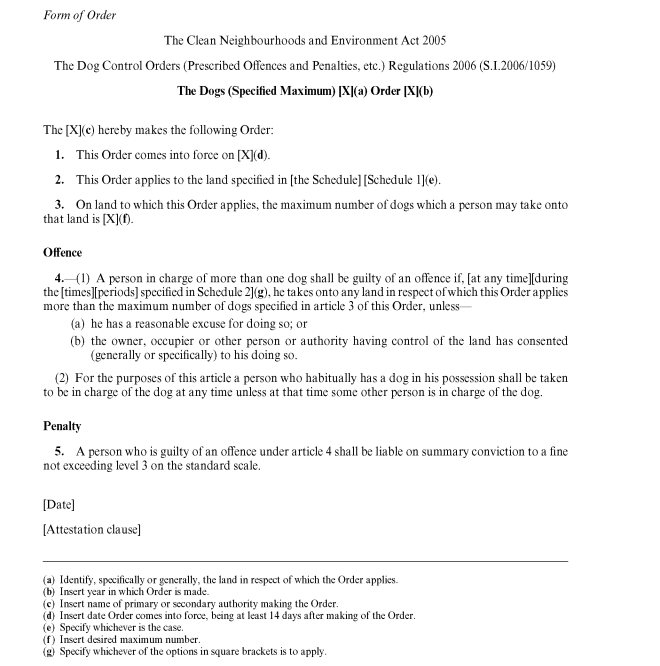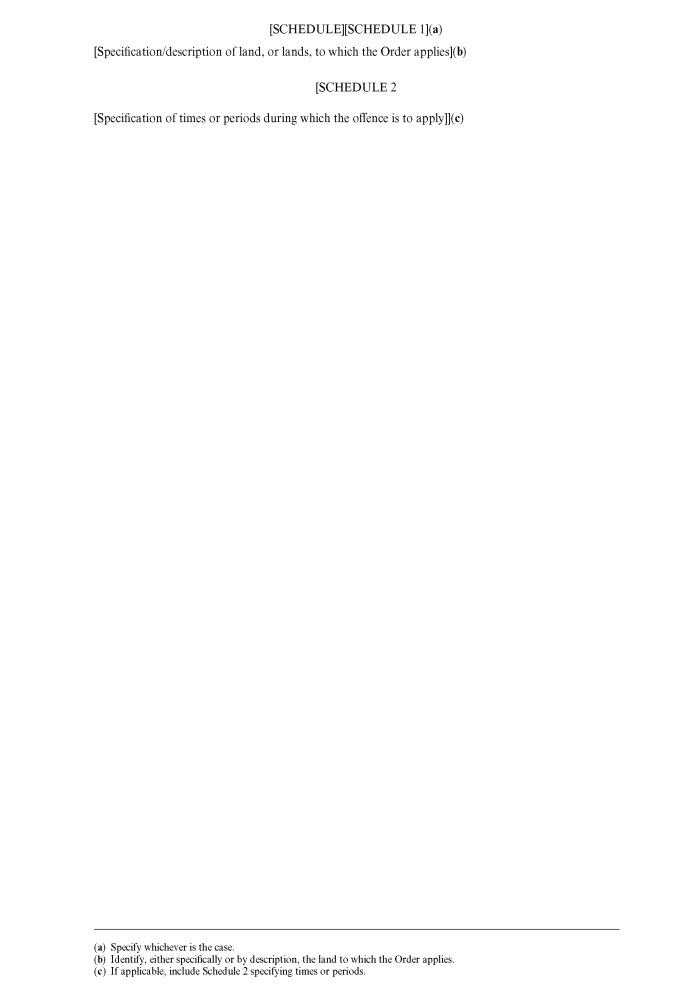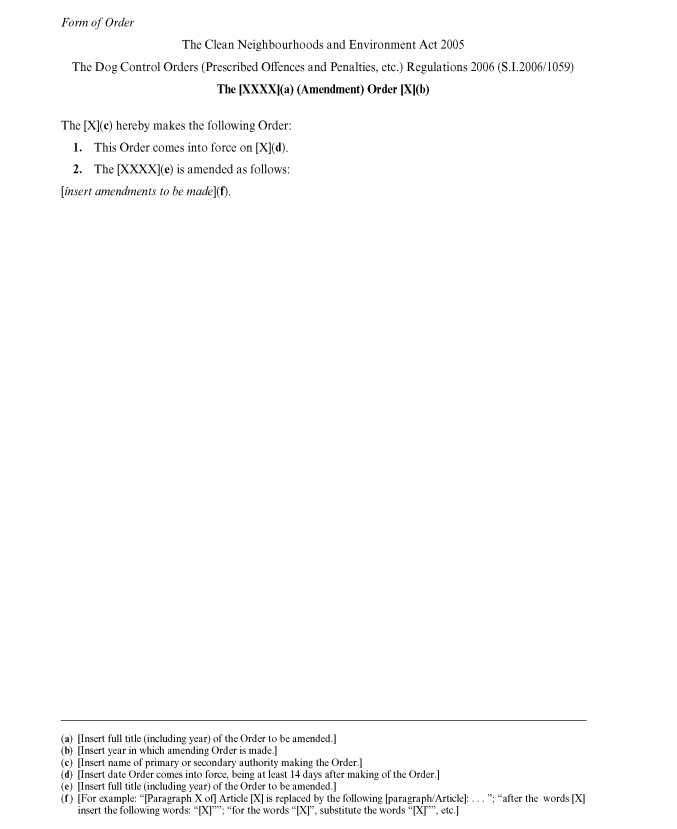- Y Diweddaraf sydd Ar Gael (Diwygiedig)
- Gwreiddiol (a wnaed Fel)
The Dog Control Orders (Prescribed Offences and Penalties, etc.) Regulations 2006
You are here:
- Offerynnau Statudol y Deyrnas Unedig
- 2006 No. 1059
- Whole Instrument
- Blaenorol
- Nesaf
- Dangos Graddfa Ddaearyddol(e.e. Lloegr, Cymru, Yr Alban aca Gogledd Iwerddon)
- Dangos Llinell Amser Newidiadau
Rhagor o Adnoddau
Changes over time for: The Dog Control Orders (Prescribed Offences and Penalties, etc.) Regulations 2006
Alternative versions:
Changes to legislation:
There are outstanding changes not yet made by the legislation.gov.uk editorial team to The Dog Control Orders (Prescribed Offences and Penalties, etc.) Regulations 2006. Any changes that have already been made by the team appear in the content and are referenced with annotations.![]()
Changes to Legislation
Revised legislation carried on this site may not be fully up to date. Changes and effects are recorded by our editorial team in lists which can be found in the ‘Changes to Legislation’ area. Where those effects have yet to be applied to the text of the legislation by the editorial team they are also listed alongside the legislation in the affected provisions. Use the ‘more’ link to open the changes and effects relevant to the provision you are viewing.
Changes and effects yet to be applied to :
- Sch. 1 para. 1(3) words inserted by S.I. 2016/211 Sch. 3 para. 75
- Sch. 4 para. 1(3) words inserted by S.I. 2016/211 Sch. 3 para. 75
Changes and effects yet to be applied to the whole Instrument associated Parts and Chapters:
Whole provisions yet to be inserted into this Instrument (including any effects on those provisions):
- Sch. 2 para. 2(2) omitted by 2012 c. 10 Sch. 9 para. 19
Statutory Instruments
2006 No. 1059
DOGS, ENGLAND
CONTROL OF DOGS
The Dog Control Orders (Prescribed Offences and Penalties, etc.) Regulations 2006
Made
5th April 2006
Coming into force in accordance with regulation 1(b)
The Secretary of State, being the appropriate person in relation to England as defined in section 66(a) of the Clean Neighbourhoods and Environment Act 2005(1), makes the following Regulations in exercise of the powers conferred by sections 55(4) and (5), 56(1) and (3) and 67(1) of that Act.
In accordance with section 67(3) of that Act, a draft of this instrument has been laid before Parliament and approved by a resolution of each House of Parliament.
Title, commencement and applicationE+W
1. These Regulations—
(a)may be cited as the Dog Control Orders (Prescribed Offences and Penalties, etc.) Regulations 2006;
(b)come into force on the day after the day on which they are made;
(c)apply in England only.
InterpretationE+W
2. In these Regulations—
“the Act” means the Clean Neighbourhoods and Environment Act 2005;
an “Authority” means either a primary authority or a secondary authority within the meaning of section 58 (primary and secondary authorities) of the Act.
Prescribed offences and penaltiesE+W
3.—(1) For the purposes of section 55(4) of the Act, the offences capable of being provided for in a dog control order are those set out in paragraph 1 of each of Schedules 1 to 5.
(2) The penalty to be provided in relation to any offence in a dog control order is, on summary conviction, a fine not exceeding level 3 on the standard scale.
(3) A dog control order may specify the times at which, or the periods during which, an offence is to apply.
Specified wording to be used in, and the form of, a dog control orderE+W
4. An Authority which makes a dog control order shall—
(a)in providing for any offence, use the wording specified in the Schedule applying to that offence (under the heading “offence”); and
(b)in all other respects make the order in the form set out in the said Schedule, or in a form substantially to the like effect.
Amendment of a dog control orderE+W
5. An Authority which amends a dog control order it has made shall do so in accordance with Schedule 6.
Coming into force of a dog control orderE+W
6. The date of coming into force of a dog control order (including an order amending a dog control order) shall be at least 14 days after the date on which the order is made.
Ben Bradshaw
Parliamentary Under Secretary of State
Department for Environment, Food and Rural Affairs
5th April 2006
Regulations 3 and 4
SCHEDULE 1E+WOFFENCE OF FAILING TO REMOVE DOG FAECES and FORM OF ORDER
1.—(1) Subject to sub-paragraphs (2) and (3), it is an offence when being in charge of a dog on land to which a dog control order (described as a “Fouling of Land by Dogs Order” in the form set out below) applies, not to remove faeces deposited by the dog at any time, or at any time during certain periods prescribed in the order.E+W
(2) No offence is committed where a person has a reasonable excuse for failing to remove the faeces, or the owner, occupier or other person or authority having control of the land has consented (generally or specifically) to his failing to do so.
(3) The offence does not apply to a person who is registered as a blind person in a register compiled under section 29 of the National Assistance Act 1948, or to a person who has a disability which affects his mobility, manual dexterity, physical co-ordination or ability to lift, carry or otherwise move everyday objects, in respect of a dog trained by Dogs for the Disabled (registered charity number 700454), Support Dogs (registered charity number 1088281) or Canine Partners for Independence (registered charity number 803680) and upon which he relies for assistance.
2. In any Fouling of Land by Dogs Order, the offence of failing to remove dog faeces is to be set out in full as stated in article 3 in the form of order given below.E+W
3. In all other respects, a Fouling of Land by Dogs Order providing for that offence is to be in the form given below, or in a form substantially to the like effect.E+W
Regulations 3 and 4
SCHEDULE 2E+WOFFENCE OF NOT KEEPING A DOG ON A LEAD and FORM OF ORDER
1.—(1) Subject to sub-paragraph (2), it is an offence when being in charge of a dog on land to which a dog control order (described as a “Dogs on Leads Order” in the form set out below) applies, not to keep the dog on a lead or on a lead of a maximum length prescribed in the order, during such times or periods as may be prescribed.E+W
(2) No offence is committed where a person has a reasonable excuse for failing to keep the dog on a lead, or the owner, occupier or other person or authority having control of the land has consented (generally or specifically) to his failing to do so.
2. In any Dogs on Leads Order, the offence of not keeping a dog on a lead is to be set out in full as stated in article 3 in the form of the order given below.E+W
3. In all other respects, a Dogs on Leads Order providing for that offence is to be in the form given below, or in a form substantially to the like effect.E+W
Regulations 3 and 4
SCHEDULE 3E+WOFFENCE OF NOT PUTTING AND KEEPING A DOG ON A LEAD, UNDER DIRECTION and FORM OF ORDER
1.—(1) Subject to sub-paragraph (2), it is an offence when being in charge of a dog on land to which a dog control order (described as a “Dogs on Leads by Direction Order” in the form set out below) applies, not to put, and thereafter keep, the dog on a lead or on a lead of a maximum length prescribed in the order, during such times or periods as may be prescribed, when directed to do so by an authorised officer of an Authority.E+W
(2) No offence is committed where a person has a reasonable excuse for failing to comply with a direction to put and keep the dog on a lead, or the owner, occupier or other person or authority having control of the land has consented (generally or specifically) to his failing to do so.
2. In any Dogs on Leads by Direction Order, the offence of not putting and keeping a dog on a lead, by direction, is to be set out in full as stated in article 4 in the form of the order given below.E+W
3. In all other respects, a Dogs on Leads by Direction Order providing for that offence is to be in the form given below, or in a form substantially to the like effect.E+W
Regulations 3 and 4
SCHEDULE 4E+WOFFENCE OF PERMITTING A DOG TO ENTER LAND FROM WHICH IT IS EXCLUDED and FORM OF ORDER
1.—(1) Subject to sub-paragraphs (2) and (3), it is an offence when being in charge of a dog on land to which a dog control order (described as a “Dogs Exclusion Order” in the form set out below) applies, during such times or periods as may be specified in the order, to take the dog onto, or to permit it to enter or to remain on, such land.E+W
(2) No offence is committed where a person has a reasonable excuse for taking the dog onto, or permitting it to enter or remain on, the land, or the owner, occupier or other person or authority having control of the land has consented (generally or specifically) to his doing so.
(3) The offence does not apply to a person who is registered as a blind person in a register compiled under section 29 of the National Assistance Act 1948, to a deaf person in respect of a dog trained by Hearing Dogs for Deaf People (registered charity number 293358), or to a person who has a disability which affects his mobility, manual dexterity, physical co-ordination or ability to lift, carry or otherwise move everyday objects, in respect of a dog trained by Dogs for the Disabled (registered charity number 700454), Support Dogs (registered charity number 1088281) or Canine Partners for Independence (registered charity number 803680) and upon which he relies for assistance.
2. In any Dogs Exclusion Order, the offence of taking a dog onto, or permitting it to enter or to remain on, land from which it is excluded is to be set out in full as stated in article 3 in the form of the order given below.E+W
3. In all other respects, a Dogs Exclusion Order providing for that offence is to be in the form given below, or in a form substantially to the like effect.E+W
Regulations 3 and 4
SCHEDULE 5E+WOFFENCE OF TAKING MORE THAN A SPECIFIED NUMBER OF DOGS ONTO LAND and FORM OF ORDER
1.—(1) Subject to sub-paragraph (2), it is an offence when being in charge of more than one dog on land to which a dog control order (described as a “Dogs (Specified Maximum) Order” in the form set out below) applies, during such times or periods as may be specified in the order, to take more than the maximum number of dogs specified in the order onto that land.E+W
(2) No offence is committed where a person has a reasonable excuse for taking more than the specified maximum number of dogs onto the land, or the owner, occupier or other person or authority having control of the land has consented (generally or specifically) to his doing so.
2. In any Dogs (Specified Maximum) Order, the offence of taking more than a specified number of dogs onto land is to be set out in full as stated in article 4 in the form of order given below.E+W
3. In all other respects, a Dogs (Specified Maximum) Order providing for that offence is to be in the form given below, or in a form substantially to the like effect.E+W
Regulation 5
SCHEDULE 6E+WFORM OF ORDER AMENDING A DOG CONTROL ORDER
1. An order amending a dog control order shall be in the form given below, or in a form substantially to the like effect.E+W
2. Where the amendment is to the description of an offence, the amendment shall be made by substituting the entire article which sets out the offence, and the substituted article shall set out the offence as it is required to be stated were it contained in a newly made dog control order.E+W
Explanatory Note
(This note is not part of the Regulations)
These Regulations, which apply in England, come into force on 6th April 2006.
Further to Chapter 1 (control of dogs) of Part 6 (in particular, sections 55 to 58) of the Clean Neighbourhoods and Environment Act 2005 (c. 16) (“the Act”), under which certain authorities are empowered to make dog control orders, these Regulations prescribe for the purposes of section 55 of the Act the offences that may be provided for in any such order (regulation 3(1) and Schedules 1 to 5).
The offences are:
(a)failing to remove faeces deposited by a dog on land in respect of which a Fouling of Land by Dogs Order applies (Schedule 1, paragraph 1);
(b)failing to keep a dog on a lead on land in respect of which a Dogs on Leads Order applies (Schedule 2, paragraph 1);
(c)failing to put, and to keep, a dog on a lead, when directed to do so by an authorised officer, on land in respect of which a Dogs on Leads by Direction Order applies (Schedule 3, paragraph 1);
(d)permitting a dog to enter land in respect of which a Dogs Exclusion Order applies (Schedule 4, paragraph 1); and
(e)taking more than the maximum number of dogs onto land in respect of which a Dogs (Specified Maximum) Order applies (Schedule 5, paragraph 1),
in each case without reasonable excuse or without the consent of the owner, occupier or other person or authority who has control of the land. The offences of failing to remove dog faeces and of permitting a dog to enter land from which dogs are excluded do not apply to a person who is registered as a blind person or to a person who has a disability in respect of which he relies on the assistance of a dog trained by a specified charity; the offence of permitting a dog to enter land from which dogs are excluded also does not apply to a person who is deaf in respect of a dog trained by a specified charity.
The Regulations also prescribe, in fulfilment of the requirement in section 56(1) of the Act, the maximum penalty which may be provided for in a dog control order (regulation 3(2)); this shall be, on summary conviction, a fine not exceeding level 3 on the standard scale (that is, at the time of making these Regulations, £1,000).
In respect of the content and form of a dog control order, the Regulations specify the wording that must be used in providing for an offence in such an order (regulation 4(a), and in paragraph 2 of Schedules 1 to 5), and in all other respects require that a dog control order (including an order amending a dog control order) shall be in the form set out in the appropriate Schedule, or in a form substantially to the like effect as that form (regulation 4(b), and in paragraph 3 of Schedules 1 to 5; in respect of an amending order, regulation 5 and Schedule 6, paragraph 1).
A full regulatory impact assessment of the effect of the then Clean Neighbourhoods and Environment Bill was prepared (dog control orders are dealt with on pp. 58–60), and was deposited in the libraries of both Houses of Parliament; copies of it are available from the Department for Environment, Food and Rural Affairs, Ashdown House, 123 Victoria Street, London SW1E 6DE. A separate regulatory impact assessment has not been produced for these Regulations as they have no impact on the costs of business.
Options/Help
Print Options
PrintThe Whole Instrument
Mae deddfwriaeth ar gael mewn fersiynau gwahanol:
Y Diweddaraf sydd Ar Gael (diwygiedig):Y fersiwn ddiweddaraf sydd ar gael o’r ddeddfwriaeth yn cynnwys newidiadau a wnaed gan ddeddfwriaeth ddilynol ac wedi eu gweithredu gan ein tîm golygyddol. Gellir gweld y newidiadau nad ydym wedi eu gweithredu i’r testun eto yn yr ardal ‘Newidiadau i Ddeddfwriaeth’.
Gwreiddiol (Fel y’i Deddfwyd neu y’i Gwnaed): Mae'r wreiddiol fersiwn y ddeddfwriaeth fel ag yr oedd pan gafodd ei deddfu neu eu gwneud. Ni wnaed unrhyw newidiadau i’r testun.
Gweler y wybodaeth ychwanegol ochr yn ochr â’r cynnwys
Rhychwant ddaearyddol: Indicates the geographical area that this provision applies to. For further information see ‘Frequently Asked Questions’.
Dangos Llinell Amser Newidiadau: See how this legislation has or could change over time. Turning this feature on will show extra navigation options to go to these specific points in time. Return to the latest available version by using the controls above in the What Version box.
Memorandwm Esboniadol
Mae Memoranda Esboniadol yn nodi datganiad byr o ddiben Offeryn Statudol ac yn rhoi gwybodaeth am ei amcan polisi a goblygiadau polisi. Maent yn ceisio gwneud yr Offeryn Statudol yn hygyrch i ddarllenwyr nad oes ganddynt gymhwyster cyfreithiol, ac maent yn cyd-fynd ag unrhyw Offeryn Statudol neu Offeryn Statudol Drafft a gyflwynwyd ger bron y Senedd o Fehefin 2004 ymlaen.
Rhagor o Adnoddau
Gallwch wneud defnydd o ddogfennau atodol hanfodol a gwybodaeth ar gyfer yr eitem ddeddfwriaeth o’r tab hwn. Yn ddibynnol ar yr eitem ddeddfwriaeth sydd i’w gweld, gallai hyn gynnwys:
- y PDF print gwreiddiol y fel deddfwyd fersiwn a ddefnyddiwyd am y copi print
- rhestr o newidiadau a wnaed gan a/neu yn effeithio ar yr eitem hon o ddeddfwriaeth
- manylion rhoi grym a newid cyffredinol
- pob fformat o’r holl ddogfennau cysylltiedig
- slipiau cywiro
- dolenni i ddeddfwriaeth gysylltiedig ac adnoddau gwybodaeth eraill
Llinell Amser Newidiadau
This timeline shows the different points in time where a change occurred. The dates will coincide with the earliest date on which the change (e.g an insertion, a repeal or a substitution) that was applied came into force. The first date in the timeline will usually be the earliest date when the provision came into force. In some cases the first date is 01/02/1991 (or for Northern Ireland legislation 01/01/2006). This date is our basedate. No versions before this date are available. For further information see the Editorial Practice Guide and Glossary under Help.
Rhagor o Adnoddau
Defnyddiwch y ddewislen hon i agor dogfennau hanfodol sy’n cyd-fynd â’r ddeddfwriaeth a gwybodaeth am yr eitem hon o ddeddfwriaeth. Gan ddibynnu ar yr eitem o ddeddfwriaeth sy’n cael ei gweld gall hyn gynnwys:
- y PDF print gwreiddiol y fel gwnaed fersiwn a ddefnyddiwyd am y copi print
- slipiau cywiro
liciwch ‘Gweld Mwy’ neu ddewis ‘Rhagor o Adnoddau’ am wybodaeth ychwanegol gan gynnwys
- rhestr o newidiadau a wnaed gan a/neu yn effeithio ar yr eitem hon o ddeddfwriaeth
- manylion rhoi grym a newid cyffredinol
- pob fformat o’r holl ddogfennau cysylltiedig
- dolenni i ddeddfwriaeth gysylltiedig ac adnoddau gwybodaeth eraill
